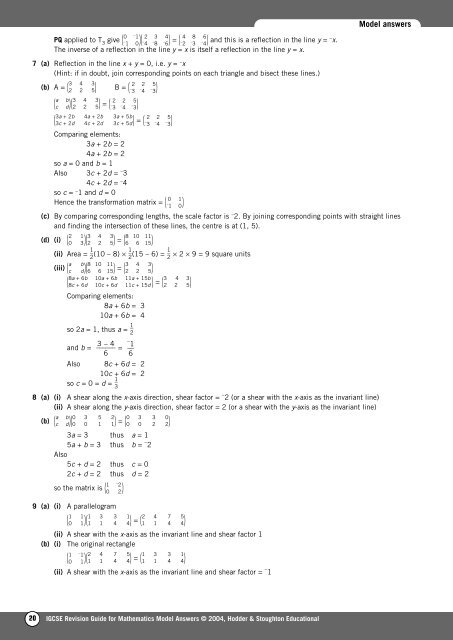Answers to all pages - Hodder Plus Home
Answers to all pages - Hodder Plus Home
Answers to all pages - Hodder Plus Home
Create successful ePaper yourself
Turn your PDF publications into a flip-book with our unique Google optimized e-Paper software.
PQ applied <strong>to</strong> T 3<br />
give ( )( ) = ( ) and this is a reflection in the line y = – x.<br />
The inverse of a reflection in the line y = x is itself a reflection in the line y = x.<br />
7 (a) Reflection in the line x + y = 0, i.e. y = – x<br />
(Hint: if in doubt, join corresponding points on each triangle and bisect these lines.)<br />
(b) A = (<br />
3 4 3<br />
) B = ( – 2 2 5<br />
2 2 5<br />
)<br />
– 3 – 4 – 3<br />
a b 3 4 3<br />
( )( ) = ( – 2 2 5<br />
c d<br />
)<br />
2 2 5 – 3 – 4 – 3<br />
3a + 2b 4a + 2b 3a + 5b<br />
( ) = ( – 2 2 5<br />
)<br />
3c + 2d 4c + 2d 3c + 5d – 3 – 4 – 3<br />
Comparing elements:<br />
3a + 2b = 2<br />
4a + 2b = 2<br />
so a = 0 and b = 1<br />
Also 3c + 2d = – 3<br />
4c + 2d = – 4<br />
so c = – 1 and d = 0<br />
Hence the transformation matrix = (<br />
0 1<br />
)<br />
– 1 0<br />
Model answers<br />
(c) By comparing corresponding lengths, the scale fac<strong>to</strong>r is – 2. By joining corresponding points with straight lines<br />
and finding the intersection of these lines, the centre is at (1, 5).<br />
2 1 3 4 3<br />
(d) (i) ( 0 3)( 2 2 5) = ( 6 6 15)<br />
1 1<br />
(ii) Area = (10 – 8) × – (15 – 6) = –<br />
2<br />
2 × 2 × 9 = 9 square units<br />
(iii) (<br />
a b<br />
)(<br />
8 10 11<br />
) = (<br />
3 4 3<br />
c d 6 6 15 2 2 5 )<br />
8a + 6b 10a + 6b 11a + 15b<br />
( ) = 3 4 3<br />
( )<br />
8c + 6d 10c + 6d 11c + 15d 2 2 5<br />
Comparing elements:<br />
8a + 6b = 3<br />
10a + 6b = 4<br />
1<br />
so 2a = 1, thus a = –<br />
2<br />
3 – 4<br />
and b = =<br />
– 1<br />
–––––– ––6<br />
6<br />
Also 8c + 6d = 2<br />
10c + 6d = 2<br />
1<br />
so c = 0 = d = –<br />
3<br />
8 (a) (i) A shear along the x-axis direction, shear fac<strong>to</strong>r = – 2 (or a shear with the x-axis as the invariant line)<br />
(ii) A shear along the y-axis direction, shear fac<strong>to</strong>r = 2 (or a shear with the y-axis as the invariant line)<br />
(b) (<br />
a b<br />
)(<br />
0 3 5 2<br />
) = (<br />
0 3 3 0<br />
c d 0 0 1 1 0 0 2 2 )<br />
3a = 3 thus a = 1<br />
5a + b = 3 thus b = – 2<br />
Also<br />
5c + d = 2 thus c = 0<br />
2c + d = 2 thus d = 2<br />
so the matrix is (<br />
1<br />
– 2<br />
0 2 )<br />
9 (a) (i) A par<strong>all</strong>elogram<br />
0<br />
– 1<br />
– 2 3 4<br />
– 1 0<br />
– 4 – 8 – 6<br />
1 –2<br />
8 10 11<br />
1 1 1 3 3 1<br />
( )( ) = 2 4 7 5<br />
( )<br />
0 1 1 1 4 4 1 1 4 4<br />
(ii) A shear with the x-axis as the invariant line and shear fac<strong>to</strong>r 1<br />
(b) (i) The original rectangle<br />
1<br />
( – 1 2 4 7 5<br />
)( ) = 1 3 3 1<br />
0 1<br />
( )<br />
1 1 4 4 1 1 4 4<br />
– 4 8 6<br />
– 2 – 3 – 4<br />
(ii) A shear with the x-axis as the invariant line and shear fac<strong>to</strong>r = – 1<br />
20<br />
IGCSE Revision Guide for Mathematics Model <strong>Answers</strong> © 2004, <strong>Hodder</strong> & S<strong>to</strong>ugh<strong>to</strong>n Educational

















